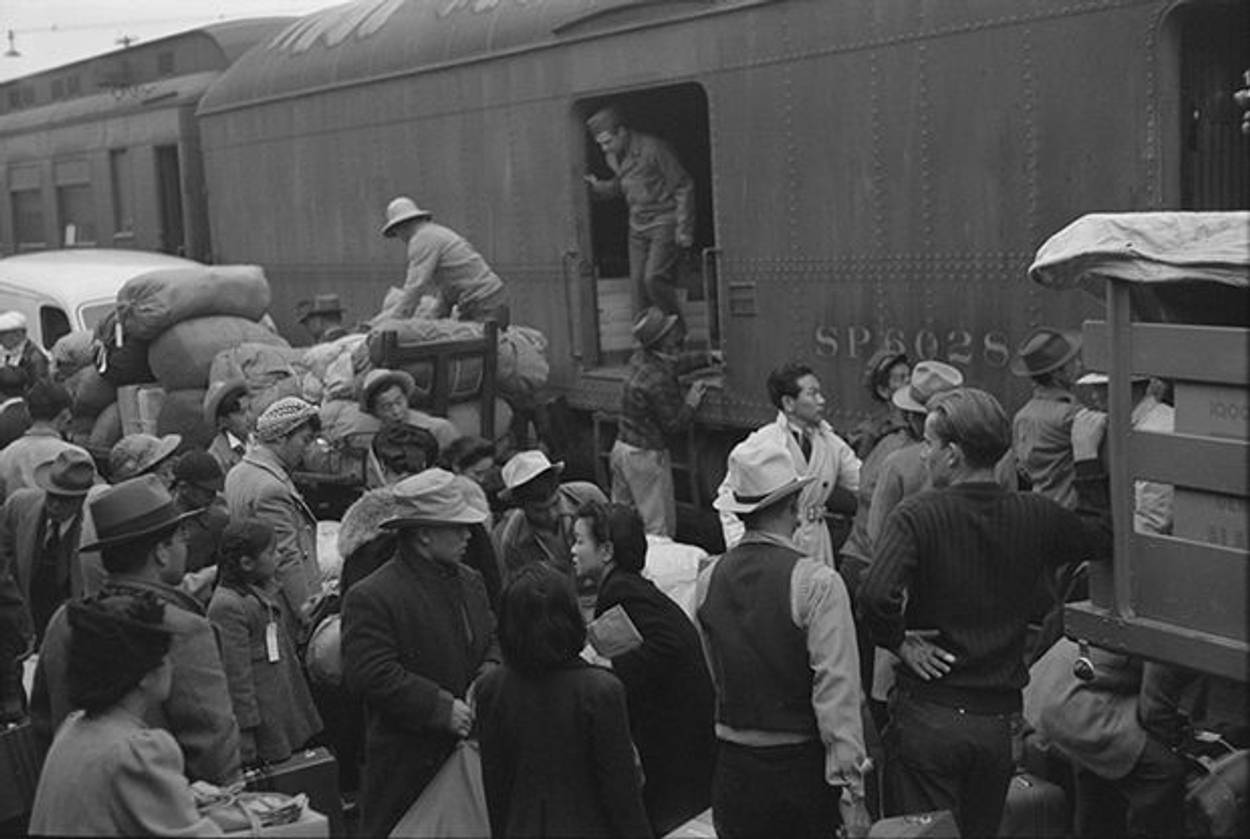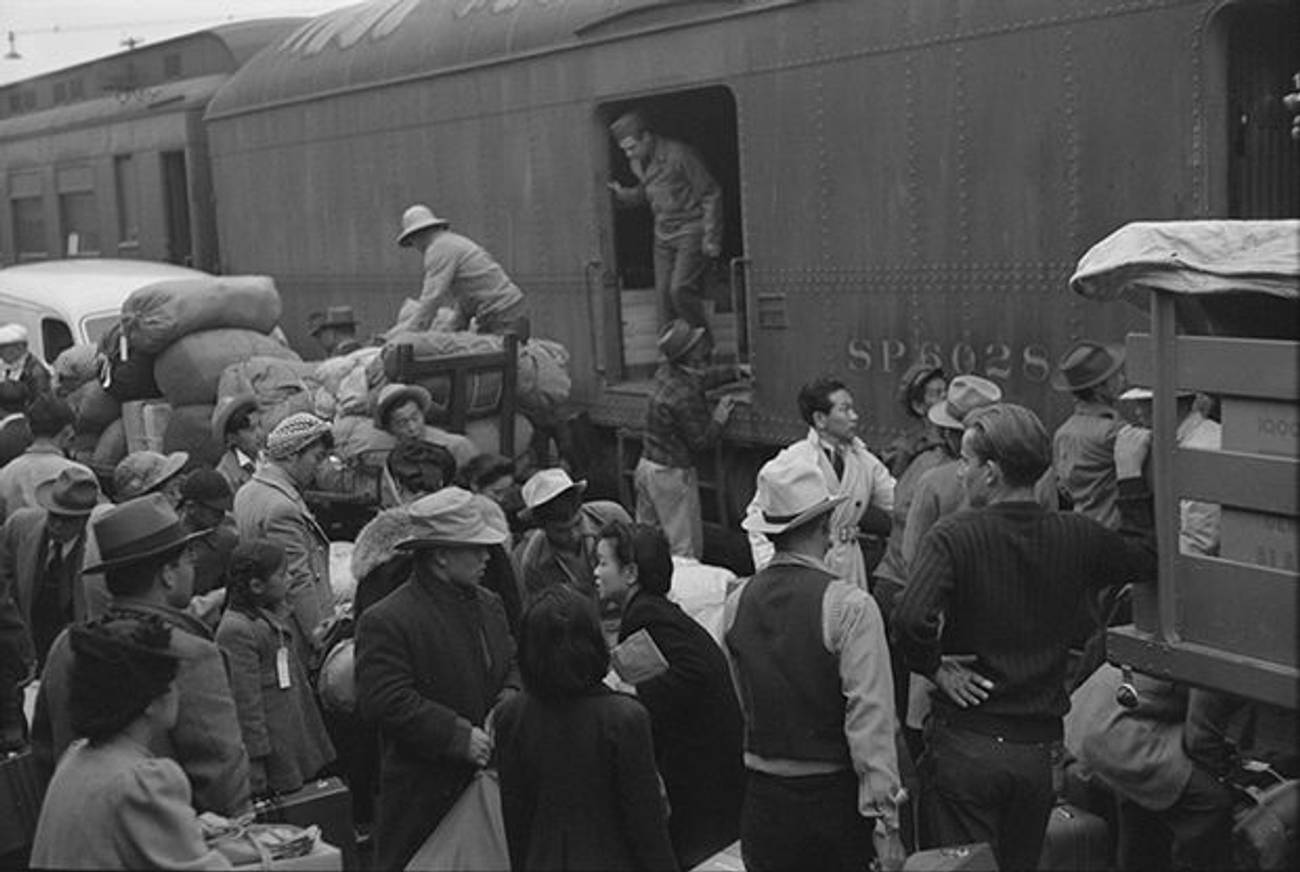Why Didn’t FDR Help European Jews? Hints in His Decision to Intern Japanese Americans
Now, 75 years after the Supreme Court upheld the internment of civilians in World War II, it may revisit the ruling




Shortly after the Japanese attack on Pearl Harbor, in December 1941, some of the United States’ most senior military officials began advocating for President Franklin Delano Roosevelt to order the mass detention of Japanese Americans. “The Japanese race is an enemy race,” wrote Lt. Gen. John DeWitt, the man in charge of the Western Defense Command. “And while many second and third-generation Japanese born on United States soil, possessed of United States citizenship, have become ‘Americanized,’ the racial strains are undiluted.”
Although there were a few voices in the administration against internment—particularly Attorney General Francis Biddle and Gen. Mark Clark, the Army’s deputy chief of staff—the president disregarded the dissenters. On Feb. 19, 1942, Roosevelt signed Executive Order 9066, authorizing the military to remove anyone from any area of the country, if deemed necessary for national security. During the months that followed, more than 110,000 Japanese Americans were rounded up throughout California and shipped to internment camps in Arizona, Wyoming, Arkansas, and elsewhere. Fred Korematsu, a resident of San Leandro, on the San Francisco Bay, resisted deportation and was arrested, setting in motion a legal struggle that went all the way to the Supreme Court. In 1944, the court ruled, 6-3, in favor of the government’s action.
That ruling has quietly remained on the books all these years. But it may be revisited shortly if the court accepts a recent request to hear Hedges v. Obama, in which the plaintiff is challenging a 2012 law permitting the detention without trial of suspected supporters of terrorism. The wording of that 2012 legislation relies in part on the 1944 Korematsu decision. In a possible hint of which way the court is leaning, Justice Antonin Scalia said in a speech at the University of Hawaii last week that the internment of the Japanese was “wrong”—although he added, “You are kidding yourself if you think the same thing would not happen again.” [Editor’s note: On Jun. 26, 2018, Chief Justice John Roberts, writing the majority opinion of the Supreme Court in Trump v. Hawaii, stated in obiter dictum that Korematsu v. United States was wrongly decided, indicating a majority of the court agreed to overrule it.]
But while the Supreme Court may reconsider the issue, not everyone is willing to take a fresh look at the controversy. The recently re-opened Franklin D. Roosevelt Presidential Library and Museum in upstate New York includes a section on the roundup of the Japanese but skirts the most explosive research about Roosevelt’s motives. And that research, in turn, has an unexpected but important connection to the ever-simmering issue of FDR’s response to the Holocaust.
In 1980, Congress established the Commission on Wartime Relocation and Internment of Civilians. Its final report, titled Personal Justice Denied, concluded that the internment was motivated by “race prejudice, war hysteria, and a failure of political leadership,” and recommended reparations of $20,000 to each surviving internee. After additional lobbying by Japanese American activists, legislation was eventually passed to distribute those funds, and both Presidents Ronald Reagan and George H.W. Bush issued public apologies for the internment.
More recently, in response to additional public education efforts by Japanese Americans, 10 sites of former detention camps were designated historical landmarks. Last April, a Japanese American Internment Museum was established near the site of the Rohwer camp, in Arkansas. The ceremony opening the museum was headlined by actor George Takei, best known for his role as Lt. Hikaru Sulu in the Star Trek television series and movies. Takei described how, at age 5, he and his family “were forced from our home in Los Angeles at gunpoint by U.S. soldiers and sent to Rohwer, all because we happened to look like the people who bombed Pearl Harbor.” His childhood was spent “in the swamps—fetid, hot, mosquito-laden. … Block 6, Barrack 2, Unit F. We were little more than numbers to our jailers, each of us given a tag to wear like a piece of luggage. My tag was 12832-C.”
Takei’s fame has helped open doors for him to educate the public about the internment, and he has lectured widely on the subject in recent years. (He also recently starred in Allegiance, a Broadway musical based on the experiences of a family similar to the Takeis during their years of detention.) The Star Trek alumnus has visited the site of the Dachau concentration camp, in Germany. The all-Japanese 522nd Field Artillery Battalion was one of the U.S. army units that liberated Hurlach, a slave labor site that was a sub-camp of Dachau. They also liberated a group of Jewish prisoners who were on a death march out of Dachau. “In my mind, I’ve always tried to draw a strong distinction between the internment camps and the extermination camps,” Takei told the San Diego Jewish Journal in 2012. “And what had the Jews done to deserve death? The stereotype was that they were ‘shrewd.’ Just like we’re supposed to be ‘inscrutable.’ That was our crime.”
As it turns out, the parallels between anti-Jewish and anti-Japanese stereotypes to which Takei alluded are crucial to understanding both Roosevelt’s decision on Japanese internment and his response to the Holocaust. Even FDR’s most ardent supporters today concede that the internment was wrong. The website of the Roosevelt presidential library, in Hyde Park, N.Y., calls the decision “a blemish on Roosevelt’s wartime record,” and curriculum materials designed for schools by the museum characterize it as “a great injustice.” At the same time, however, the museum, which recently re-opened after a nine-year, $30-million revamp and expansion, portrays the president as the victim of irresistible pressure from his military advisers and public opinion.
The museum’s exhibition on the Japanese internment makes no mention of the last decade’s most important new research findings concerning the motives behind the internment decision. By Order of the President, a critically acclaimed 2001 book by Greg Robinson, an American historian at the University of Quebec, revealed a number of incendiary articles about Asians that Franklin Roosevelt wrote in the 1920s. In those articles, the future president asserted that “the mingling of Asiatic blood with European or American blood produces, in nine cases out of ten, the most unfortunate results.” FDR argued that because “Japanese immigrants are not capable of assimilation into the American population,” they could not be trusted and their right to purchase land should be restricted.
Interestingly, the museum does include the cover of By Order of the President, and a brief excerpt from the book, in a side panel—so nobody can claim the museum completely ignores Robinson’s book. But the excerpt they chose is from a passage that does not mention FDR’s writings about Asians. That choice says a lot about what the museum wants visitors to see.
Robinson concluded that FDR’s longstanding “negative beliefs about Japanese-Americans” played a significant role in the internment decision. Those beliefs help explain why Roosevelt was so quick to agree with the pro-internment positions of some of his advisers, despite the paucity of evidence of disloyalty among Japanese Americans. It also helps explain why he chose to imprison Japanese Americans, while not taking similar action against German Americans or Italian Americans despite their relation to countries America was fighting in the war.
Roosevelt’s views about the Japanese dovetail with his privately expressed opinions about Jews. In my own recent research in the diaries and correspondence of Roosevelt Cabinet members and others close to FDR, I have found a number of troubling remarks by the president in this vein. For example, he complained about Jews “overcrowding” certain professions in Germany, North Africa, and even in Oregon. He was one of the initiators of a quota on the admission of Jews to Harvard. He boasted to one friend—a U.S. senator—that “we have no Jewish blood in our veins.” He claimed antisemitism in Poland was a reaction to Jews dominating the local economy. And he embraced an adviser’s proposal to “spread the Jews thin” around the world, in order to prevent them from dominating their host countries.
FDR’s writings and statements indicate that he regarded both Jews and Asians as having innate biological characteristics that made it difficult, or even impossible, for them to become fully loyal Americans. Certain individual, assimilated Jews could be useful to him as political allies or advisers, but having a substantial number of Jews, especially the less assimilated kind, was—in his mind—inviting trouble.
FDR’s private views help explain an otherwise inexplicable aspect of his response to the Holocaust–his administration’s policy of suppressing refugee immigration far below the legal limits. The quota of immigrants from Germany (about 26,000 annually) was filled in only one year out of Roosevelt’s 12 in the White House. In most of those years, it was less than 25 percent filled. If public or congressional opposition prevented liberalizing the entire immigration quota system, why not at least permit the existing quotas to be quietly filled? The answer is that Franklin Roosevelt’s vision of America did not make room for substantial numbers of Asian or Jewish immigrants.
It’s not that prejudice was the only factor that went into Roosevelt’s internment of the Japanese or his response to the Holocaust. Obviously there were various political, military, and other factors that figured into the mix. But museum curators and historians who discount the importance of the president’s personal feelings are missing a crucial, and undeniable, aspect of the story.
Rafael Medoff is director of The David S. Wyman Institute for Holocaust Studies, in Washington, D.C. His latest book is FDR and the Holocaust: A Breach of Faith.